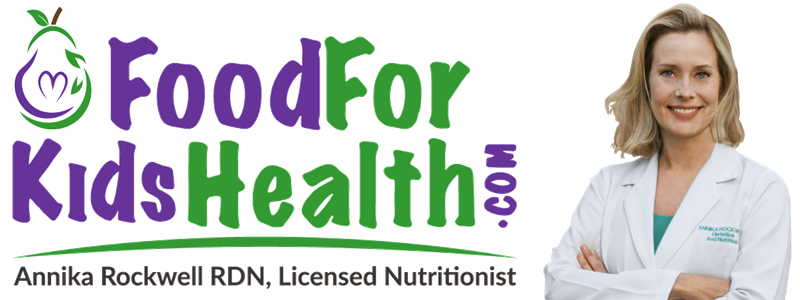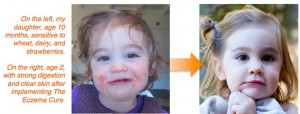If your child experiences eczema or a related skin disorder, it may be surprising to learn that these types of disorders are generally caused by a lack of enough friendly bacteria in the body, produced in the digestive tract and used by the immune system to maintain health.
From her research, Dr. Natasha Campbell-McBride, author of Gut and Psychology Syndrome, discovered a strong connection between poor intestinal flora, weak digestion and toxicity from chemicals produced by undigested foods. These issues can profoundly affect all aspects of health.
How is eczema connected to digestive health?
Everything we eat affects our digestive tract – for better or worse – and in turn, affects the rest of our body and organ systems. If your child is eating foods that are not nutrient-dense and also contribute to yeast overgrowth in the body, the result can be conditions such as eczema and others such as ear infections, asthma, and respiratory issues.
When the balance of health is interrupted, many health issues can occur. The beginnings of good gut health start at conception, with the parents. If parents have healthy flora, so will the child. If the parents do not have a good supply of beneficial bacteria in their bodies during the time of conception and this condition continues throughout pregnancy, it can adversely affect birth and your child’s health afterward.
After birth, these problems become exacerbated in children when they consume a diet of processed foods and refined sugars, and don’t receive enough nutrients. In particular, a diet high in wheat and dairy (the triggers being gluten and casein from these foods) have a profoundly negative effect on health, blood sugar, and metabolism. These problems can pre-dispose your child to experiencing various health problems, including eczema, respiratory and ear infections, as well as urinary tract infections and other issues.
Other factors in gut health
Medications or immunizations (both by the parents before conception and during breastfeeding, and the children afterward) have a negative effect on gut health. These substances contribute to severe problems in the digestive tract, leading to more illness, allergic reactions, and infections:
- steroids and antibiotics
- contraceptive pills
- over-the-counter drugs like aspirin and ibuprofen
- vaccines
Allergies and intolerances
Food allergies and intolerances express themselves in the symptoms your child experiences, such as the skin irritation occurring with eczema. These reactions are a continual source of stress to the immune system of a developing and growing child. When your child has trouble digesting food, symptoms become evident not only in the digestive tract with symptoms such as stomach upset, diarrhea, or abnormal bowel movements, but also can manifest in other seemingly unrelated symptoms such eczema, pain in the joints, and headaches. In cases where food causes symptoms to occur, one of the best ways to deal with this issue is to use an elimination diet.
What does an elimination diet do for problems like eczema?
- Promotes healing in the gut
This is accomplished by: 1) avoiding foods that cause irritation and make matters worse, and 2) by only consuming foods that heal and nourish.
- Provides re-population of beneficial bacteria in the gut
By avoiding all foods that feed harmful bacteria/gut flora, you allow the digestive tract to repopulate itself with good bacteria that support health. Also a high quality, therapeutic probiotic supplement should be given to your child (see recommendations below) to actively repopulate the digestive tract while at the same time, nourishing and healing/starving bad bacteria.
- Removes toxins which contribute to health issues
Detoxifying is one of the most important benefits of any elimination diet. When an overgrowth of yeast occurs, fungi, bad bacteria, parasites and other issues related to gut dysbiosis (an improperly functioning intestinal tract) occurs and harmful toxins develop. These toxins have the ability to alter the physiology of our bodies and cause auto-immune reactions which suppress immunity against infections and illness. By limiting the diet to foods which are easily digested and eliminated, and by strengthening the gut and adding beneficial bacteria, the rate at which toxins are eliminated is increased.
Using an elimination diet to treat your child’s eczema and other health issues
Many children react to wheat and/or dairy foods, and you may need to eliminate these foods from their diets. Because of digestive tract compromise, it may be necessary to avoid certain foods and spend a certain amount of time healing the digestive organs in your child’s body.
First stage
While avoiding culprit foods, focus on healing foods for the digestive tract such as easy-to-digest home-made bone broths, cultured vegetables and vegetable/fruit juice combinations made at home with a juicer, and smoothies with home-made yogurt or kefir from raw milk.
Children with severe eczema and other reactions should adhere strictly to bone broths and cultured probiotic foods such as vegetables and/or dairy from raw milk until enough gut healing has occurred which will allow you to add in other foods. Children should also eat other nourishing foods as tolerated such as soups, stews, and casseroles with meats and animal products from animals/birds on pasture, and cooked vegetables.
Home juicing
Please note that you will need a home-juicing device (a blender won’t get the job done properly). Start with carrot and beet root juices, and gradually add in greens such as cucumber, celery, white and red cabbages, lettuce greens, and spinach. You can also use herbs such as dill, basil, parsley, nettle leaves, and greens from beets and carrots.
For some sweetness in the juice and to make it appealing to your child, use green apple, orange, mango, apple, pineapple, or grapes. Use a mixture of 50% therapeutic vegetables to 50% sweet fruits. Start out with ¼ to ½ cup of juice once daily, and over a period of days or possibly a week, increase to twice daily. Increase gradually over days or a week to time to 1 to 2 cups daily. Watch for reactions and taper back accordingly. Here is a video from Donna Gates of Body Ecology for fermenting cultured vegetables.
You can also try serving smoothies, first with home-made yogurt, and then kefir from raw milk. Add in a few berries or bananas and other nourishing fats like coconut oil or coconut milk, avocados, or proteins such as raw egg yolks. Again, start with small amounts such as ¼ to ½ cup once daily, and increase gradually over time. For more details, please read Dr. Natasha Campbell McBride’s book, Gut and Psychology Syndrome.
It is also important to be mindful of reactions to chemicals in soaps, cleaners, and clothing. Be sure to wash clothing and bedding with perfume-free and environmentally-safe detergents, and wash before wearing.
Food sensitivity testing
Use this test when you suspect foods which cause eczema. At bedtime, take a drop or small amount of the food you are testing and place it on the inside of the wrist of your child. Let the food dry on the wrist and allow your child to go to sleep. The following morning, check for any noticeable rash or irritation. If there is no reaction, the food is acceptable to eat. If there is a reaction, eliminate that food from your child’s menu for the time being.
Second stage
After your child has been on a healing diet for some days or weeks, those foods which may have previously caused reactions may be tried again. If you have been avoiding dairy, re-introduce it again (raw only), but stick with yogurt and then kefir at first. As time goes on, you may add in butter and sour cream made from raw milk. If you have already been giving your child cow’s milk (even raw), discontinue until after the age of 1 years old.
For relief of eczema distress as a result of irritation to the digestive tract and immune system, try the following supplements and other products:
HLC Neonate Probiotic by Pharmax. Important for intestinal health and immune response. Imbalances in the flora of the neonate may significantly increase the risk of childhood allergy and susceptibility to infectious disease. Specially formulated for the newborn infant 0-12 months and is ideal for food sensitivities to certain foods, including dairy. Scientific and usage evidence shows the HLC organisms as totally safe to use from birth, and is soluble in milk or water. Contains no wheat or gluten.
Recommended dosage: Bottle Fed Babies: Mix approximately 1/16 tsp into baby bottle (half of 1/8 tsp) once or twice daily. Breast Fed Babies: Press clean finger into powder and have baby suckle finger. Or use a tiny plastic spoon (i.e. used at the ice cream/gelato store for flavor tasting). These fit perfectly into the Neonate bottle and easily into a small mouth, and can also be smeared onto the tongue. Follow this with a little breast milk, or let your infant mash it around in the mouth with saliva. Your infant may not even notice the tiny amount of powder (it tastes slightly sweet). Approximately 33 mg (1 billion viable cells) will naturally adhere to the end of your finger. Repeat 3 times daily.
Arctic Cod Liver Oil by Nordic Naturals, 1 tsp. daily. Helps to reduce inflammation which can cause allergic reactions and provide Vitamin A & D, necessary for digestive and immune health, and growth and development.
Calendula Cream Bath and Caldendula Baby Cream by Weleda Body Care. Both products are formulated with Biodynamic® and organic calendula flower extract, and contain a base of sweet almond oil and/or beeswax to help skin retain moisture, keep it soft, smooth, and protect it from drying out. Gentle organic chamomile flower extract soothes skin with calming, natural anti-inflammatory and antiseptic properties. Developed with the assistance of midwives and physicians.
 Do you need more support on helping treat your child’s eczema? I highly recommend The Eczema Cure e-book. It will teach you step-by-step how to heal from the inside out, and it includes Real Food recipes and effective tips you cannot live without! You’ll learn safe and proven solutions that your doctor has NOT told you about since it does not involve medication or creams, and address the real cause of your eczema, and exactly what you need to do to treat it so you can enjoy healthy, radiant skin that lasts!
Do you need more support on helping treat your child’s eczema? I highly recommend The Eczema Cure e-book. It will teach you step-by-step how to heal from the inside out, and it includes Real Food recipes and effective tips you cannot live without! You’ll learn safe and proven solutions that your doctor has NOT told you about since it does not involve medication or creams, and address the real cause of your eczema, and exactly what you need to do to treat it so you can enjoy healthy, radiant skin that lasts!
Learn how to cure children’s eczema here.




